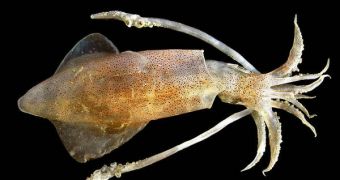While digging for fossils in the town of Chippenham, Wiltshire, in the United Kingdom, archaeologists stumbled upon the preserved remains of a squid, estimated to have lived some 150 million years ago. Inside it, much to their amazement, experts discovered ink. The substance was so well maintained, that its finders could eventually dip their pens inside it and use it for writing, the BBC News informs.
The amazing site has been excavated almost continuously since Victorian times. Hundreds of excellently preserved fossils were discovered there, some of which still had their soft tissues. This is an extremely rare event for archaeologists, because being trapped in solid rock for millions of years generally tends to strip everything from the bones, and only leaves impressions in the material. The sack of ink belonging to the squid was, for example, found only when archaeologists cracked open a rock. Inside, they found the artifact, measuring about one inch in length, perfectly preserved.
Because of the relative similarity between this ancient squid and its modern relatives, the researchers were able to use its ink to write its name and draw its diagram on a piece of paper. “We think that these creatures were swimming around during the Jurassic period and were turned to stone soon after death. It's called the Medusa effect,” the leader of the digs, British Geological Survey expert Dr. Phil Wilby, explained.
Speaking about the squid specimens discovered at Trowbridge, he added that, “They can be dissected as if they are living animals, you can see the muscle fibers and cells. It is difficult to imagine how you can have something as soft and sloppy as an ink sac fossilized in three dimension, still black, and inside a rock that is 150 million years old.”
The archeology team believes that thousands of the animals came together for the mating season in the region, before consuming poisoned algae in the water and dying. The other fossils, also dating back to the Jurassic Period, most likely fell victims to the same poisons, after they tried to eat the dead squids.

 14 DAY TRIAL //
14 DAY TRIAL //